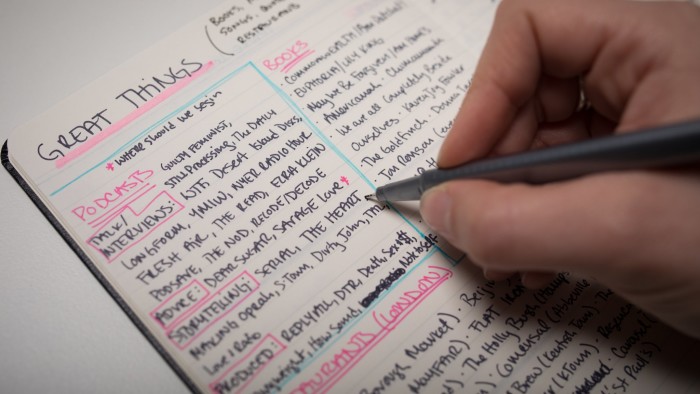Why I started a bullet journal — and so should you


Roula Khalaf, Editor of the FT, selects her favourite stories in this weekly newsletter.
Google “bullet journal”. Actually, don’t. I do not want to scare you away.
For readers who have never heard of the cult productivity system, a quick Instagram search will reveal elaborate paper diary pages created by more than 4m strangers: intricate illustrations, complex layouts, borders painted lovingly in watercolours.
Some pages have tiny boxes in which people track how often they exercise, hydrate and meditate. These self-defined “Bujo-ers” debate the perfect pens and notebooks, and the advantages of something called “washi tape”.
But bullet journals are not only about aesthetics: they are also about making you more productive. And in my case, it worked. I entered the Bullet Journal community on January 1 a sceptic. A month in, and I am hooked.
The website, built to introduce the Bujo-curious to the process, describes the bullet journal as “the analogue system for the digital age”. There is a breezy testimonial from Rebecca L: “It fundamentally changed my life”. All you need is a notebook and a pen.
At first, I rolled my eyes. Notebooks don’t change your life.
But in the dark days leading up to the new year, I had been drifting around the internet in search of a task manager that would focus my mind. I tried all sorts of apps in 2017: Asana, Todoist, Trello. I had five coffee-stained notebooks full of contextless scrawls. I had saved restaurants I had forgotten I wanted to visit in Foursquare; books I had forgotten I wanted to read in Goodreads; and thoughts I had forgotten I had recorded in my Notes app.
There was something sad about revisiting these abandoned lists. They sat there, judging me, entirely irrelevant and frozen in time. Disturbingly, Trello displayed my tasks as “ageing” if I did not update them — so the corners of each were yellowed and curled to look like ancient parchment. Something needed to change.
I stumbled across the idea of the bullet journal in a Facebook thread on productivity. “Bullet journaling helps me a ton,” wrote one stranger, to which another replied: “+1 to bullet journaling! It’s the only way I manage to get things done.”
I watched the tutorial video, which introduced an intense but flexible set of rules for filling a blank notebook to help people organise their tasks. The video was narrated by Ryder Carroll, a Brooklyn-based product designer who invented the system. The video and resources are mostly free. Mr Carroll makes money through sales of his own bullet journal, which he designed in partnership with notebook maker Leuchtturm1917, and a mobile app — but these are optional.
The system (Mr Carroll calls it a “practice”) gathers the tasks and notes we keep across apps and notebooks in one place.
It took me about a week to get started. There were a lot of rules. I had been looking for something quick and simple, but curiosity got the better of me.

The journal starts with an “index”, which works like a table of contents to help keep track of where everything is. Next is a “future log”, which shows six months of my life across one spread (I use it to remember upcoming birthdays, events and future projects), and a “monthly log” to track the month’s progress in more detail. The page numbers for each go into the index.
Because the next page is always blank, daily notes can take as little or as much space as they need — unlike a planner, which is strictly delineated. You can create additional “collections” pages for specific projects. One of my collections is a running list of restaurants in London to try.
Another is a list of books, podcasts and movies I liked, which helps when someone asks for a recommendation. You do not have to worry about these pages getting lost. Track the page number in the index and just keep moving.
Each note has a symbol that identifies what sort of action it is: a bullet, for example, is a task that needs doing. A dash is a note. A circle is an event. But it can be personalised to your preferences: for example, I use a box for tasks instead of a bullet (I like the dopamine rush from ticking a box). I have weekly logs as well as monthly ones.
“The symbols to identify the type of note was attractive to me,” said Michael Smith, an accountant from Cadillac, Michigan whom I met online, in a bullet journalling Facebook group. “It helps me to see what’s important at a glance.”
Bullet journals: Lilah’s tips
- Choose a blank notebook small enough to carry with you but thick enough to last. I use a Moleskine A5 hardcover. Many bullet journallers swear by the Leuchtturm 1917. I use ruled pages, but many prefer grids
- Use a pen you really enjoy writing with. I like to use a second colour
- Follow the tutorial to set up your journal. Don’t worry about messing up. It really doesn’t matter if your pages look ugly
- Create a legend to explain what your signifiers mean. For example: a box means task; a bullet means note; a circle means event. A star means important
- Keep it simple to begin with. The more you add to your system, the less likely you are to maintain it
- Join a bullet journal group on Facebook for ideas. A few I like are BuJo beginners and Minimalist Bullet Journals
- Stop thinking about it and just start
Here is the part that really cranks up productivity: At the start of each week, I scan through the previous week’s tasks and review those I have not checked off. I either forward that task to the week ahead (with an arrow), or cross it out. No more lost threads.
Rewriting my weekly list does not take long, and it pushes me to review my tasks and really consider whether I still care about them. If I keep writing down a task week after week, does it really need doing? No more rotting task lists. As Mr Smith puts it, “Ryder’s system helps get rid of the ‘write it down and forget it’ syndrome. Who doesn’t want to make their task list shorter? If it’s not important, I don’t want to be doing it.”
One last thing: you may be tempted to use colours. For some reason, this system has brought out my inner 13 year-old. I cannot promise that this will not happen to you.
About two weeks into my journalling I called Ryder Carroll, who laughed when I asked him if everyone found it difficult to start.
“It is asking people to think about how they are spending their time and energy on a daily basis,” he said, “And that can be a big shift for people who live in a very reactive world that is constantly looking to distract you.
“It’s easy to just react. The bullet journal is there to tell you: ‘You can stop and think about what you’re going to do next. And you might learn something about yourself when you do.’”
A month in, and I am surprised by how well this system has kept me on task. I still use Google Calendar, but have retired my other organising apps. The physicality of my notebook stops me from getting distracted when I am planning my day. It is nice to have a single log of where and how I spend my time. And, crucially, I am much more productive. My email inbox no longer dictates my priorities for the day.
My bullet journal has become a running joke among my colleagues and friends. I have come to anticipate The Look. It crosses their face as they wonder if I have joined a Marie Kondo-like cult. But slowly, they are coming around.
I fear I’m a convert. I just hope I don’t lose the thing.
*Join our new closed Facebook group, Work in Progress, where readers can candidly discuss common workplace challenges with FT journalists: from avoiding stress to advancing a career, balancing work and home, negotiating pay and more.
‘People just look scared’
In a private Facebook group dedicated to bullet journalling, I asked members if they also experience sceptical colleagues.
“I’m an attorney,” wrote one. “[My journal] raises eyebrows, but I haven’t found any other system that I can make work for the chaos that is business owner, mom, and real person with hobbies and interests.”
“I work for a public insurance brokerage firm,” wrote another. “My colleagues love my journal and are amazed how easy and simple it is, but no — no one has the bug.”
Another lawyer chimed in, “People just look scared when they see mine.”
Mr Smith had a different experience: “My assistant and family view it as me just being an organised person.”

Comments